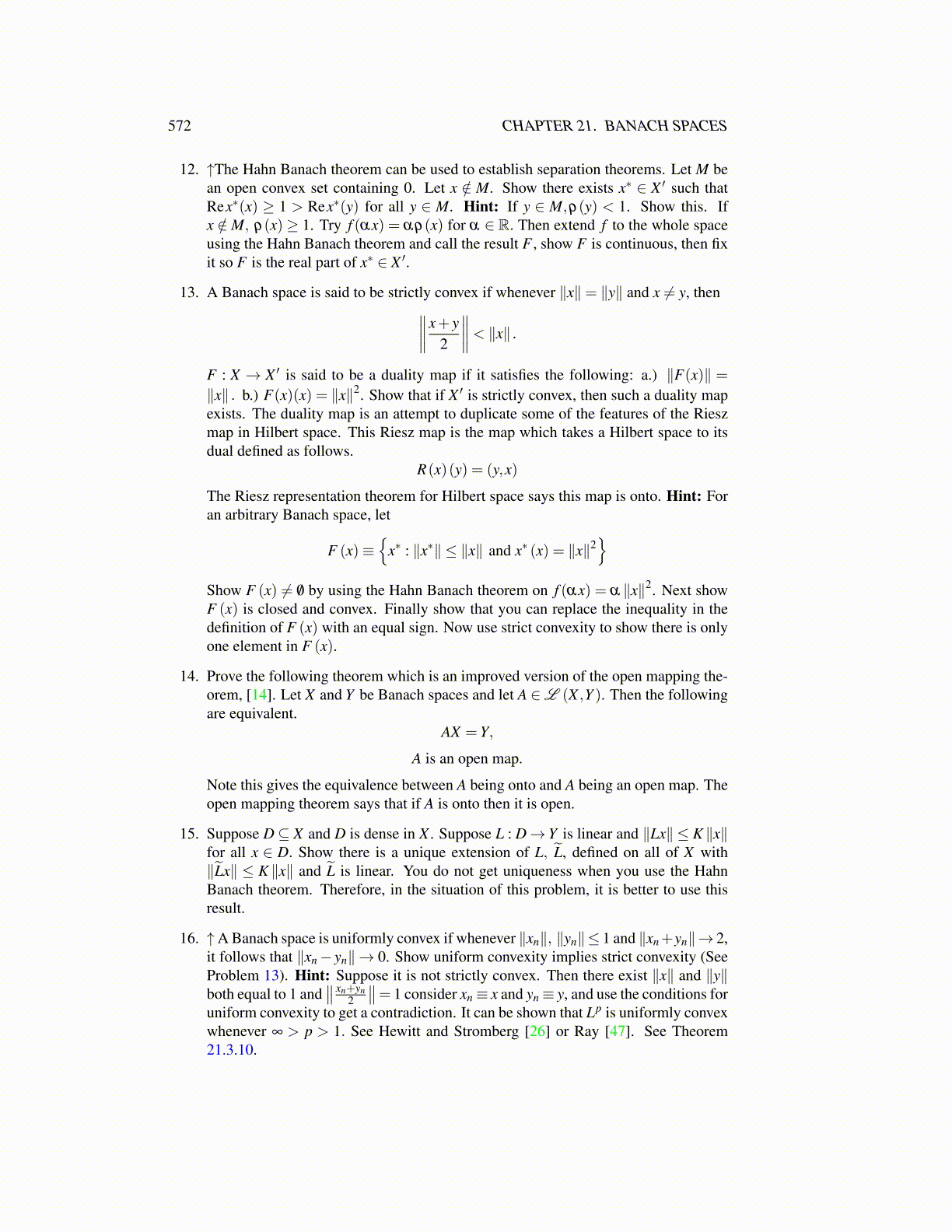
572 CHAPTER 21. BANACH SPACES
12. ↑The Hahn Banach theorem can be used to establish separation theorems. Let M bean open convex set containing 0. Let x /∈ M. Show there exists x∗ ∈ X ′ such thatRex∗(x) ≥ 1 > Rex∗(y) for all y ∈ M. Hint: If y ∈ M,ρ(y) < 1. Show this. Ifx /∈M, ρ(x)≥ 1. Try f (αx) = αρ(x) for α ∈ R. Then extend f to the whole spaceusing the Hahn Banach theorem and call the result F , show F is continuous, then fixit so F is the real part of x∗ ∈ X ′.
13. A Banach space is said to be strictly convex if whenever ∥x∥= ∥y∥ and x ̸= y, then∥∥∥∥x+ y2
∥∥∥∥< ∥x∥ .
F : X → X ′ is said to be a duality map if it satisfies the following: a.) ∥F(x)∥ =∥x∥ . b.) F(x)(x) = ∥x∥2. Show that if X ′ is strictly convex, then such a duality mapexists. The duality map is an attempt to duplicate some of the features of the Rieszmap in Hilbert space. This Riesz map is the map which takes a Hilbert space to itsdual defined as follows.
R(x)(y) = (y,x)
The Riesz representation theorem for Hilbert space says this map is onto. Hint: Foran arbitrary Banach space, let
F (x)≡{
x∗ : ∥x∗∥ ≤ ∥x∥ and x∗ (x) = ∥x∥2}
Show F (x) ̸= /0 by using the Hahn Banach theorem on f (αx) = α ∥x∥2. Next showF (x) is closed and convex. Finally show that you can replace the inequality in thedefinition of F (x) with an equal sign. Now use strict convexity to show there is onlyone element in F (x).
14. Prove the following theorem which is an improved version of the open mapping the-orem, [14]. Let X and Y be Banach spaces and let A ∈L (X ,Y ). Then the followingare equivalent.
AX = Y,
A is an open map.
Note this gives the equivalence between A being onto and A being an open map. Theopen mapping theorem says that if A is onto then it is open.
15. Suppose D⊆ X and D is dense in X . Suppose L : D→ Y is linear and ∥Lx∥ ≤ K ∥x∥for all x ∈ D. Show there is a unique extension of L, L̃, defined on all of X with∥L̃x∥ ≤ K ∥x∥ and L̃ is linear. You do not get uniqueness when you use the HahnBanach theorem. Therefore, in the situation of this problem, it is better to use thisresult.
16. ↑A Banach space is uniformly convex if whenever ∥xn∥, ∥yn∥≤ 1 and ∥xn+yn∥→ 2,it follows that ∥xn− yn∥ → 0. Show uniform convexity implies strict convexity (SeeProblem 13). Hint: Suppose it is not strictly convex. Then there exist ∥x∥ and ∥y∥both equal to 1 and
∥∥ xn+yn2
∥∥= 1 consider xn≡ x and yn≡ y, and use the conditions foruniform convexity to get a contradiction. It can be shown that Lp is uniformly convexwhenever ∞ > p > 1. See Hewitt and Stromberg [26] or Ray [47]. See Theorem21.3.10.